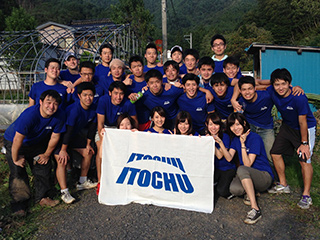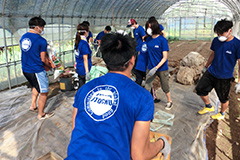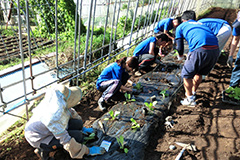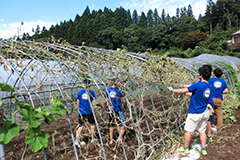Volunteer Activities Vol.27
 From September 11 to 13, new employees of the Food Company stayed in Otsuchi, a town located in Iwate Prefecture and which suffered from the Great East Japan Earthquake. These employees studied the current situation and issues of the disaster-stricken areas through voluntary agricultural activities coordinated by the Oraga Otsuchi Yume Hiroba organization.
From September 11 to 13, new employees of the Food Company stayed in Otsuchi, a town located in Iwate Prefecture and which suffered from the Great East Japan Earthquake. These employees studied the current situation and issues of the disaster-stricken areas through voluntary agricultural activities coordinated by the Oraga Otsuchi Yume Hiroba organization.
On the first day, the employees had a study tour conducted by guides who had been afflicted by the Great East Japan Earthquake and were now working to pass on their experience. The employees observed the state of the old town hall and other buildings in Otsuchi that still showed signs of damage done by the post-earthquake tsunami, and discussed various issues faced by Otsuchi at their orientation. On the second day, they participated in voluntary agricultural activities, including doing maintenance work inside greenhouses, cutting down weeds and grass, and planting seedlings. On the third day, they held a workshop at which they looked back at what they had learnt over the two days and expressed their distilled wisdom in one written Chinese character. They also gave a presentation to local university students about what kind of company ITOCHU is, and conveyed the attractiveness of ITOCHU to them. Through their experiences, the new employees realized afresh how important it is to understand the necessity of seeing things from the customer’s perspective and of knowing the front lines.
What to do for whom
Through the voluntary agricultural activities that comprised the training, I felt two things strongly.
One was the ambiguity of the word hisai-sha (people affected by the disaster). I had regarded hisai-sha uniformly as people who were affected by the disaster. By actually meeting those people, I realized that their experience on the day of the disaster and their thoughts about reconstruction are not uniform, but vary from person to person. I believe that it is only when we think about each individual person that we begin to understand hisai-sha.
The second thing I felt is how difficult the process of reconstruction is. More than four years after the earthquake, reconstruction has yet to make progress, and it became clear to me that reconstruction is by no means easy. Building houses is not all you need to do, because you have to consider what is necessary for the residents and what is important for them before proceeding with reconstruction. I realized that it takes a great amount of physical and mental energy to continue working on such questions without answers.
I learned that working on things by thinking about what to do for whom is necessary, not only for reconstruction but also for leading one’s life.

What I thought in the disaster-affected area
Through the volunteering, I learned the importance of thinking about things with a sense of ownership and without being a slave to convention or fixed ideas. By actually visiting the affected area, I gained the impression that reconstruction had yet to make significant progress, although four and a half years have passed since the earthquake. I initially thought that reconstruction simply takes a long time. However, as I thought about the issues faced by the people in the affected area and their feelings based on the situation in the area, I realized that it is very difficult to narrow down the solutions to just one. It was not until I did so that I felt that I understood the situations of the area at the time of the disaster and at present, and the feelings of the people in the area.
I was also impressed when a storyteller said, "It is up to you whether or not you have any specific thoughts about what I tell you." I heard a valuable story about the earthquake and thought that it was necessary to think about what to do if the same thing happens to me, instead of thinking that it is somebody else’s problem. I also thought that acting with such awareness would lead to the reconstruction of the affected area.

Knowing what is happening on the frontline and facing the problems
I learned two things through the training: knowing what is happening on the frontline and facing problems.
By actually visiting an affected area, I was surprised by the fact that the reconstruction had yet to make significant progress. The debris had been removed, but the town was a wasteland that had finally been bulldozed. There were few houses, which made the town lonely. One supermarket and a few restaurants were the only commercial facilities. Four and a half years after the earthquake, the number of media reports had reduced, so I had thought that the reconstruction had been put to bed. When I actually saw the hard reality, however, I became painfully aware that you cannot say anything or take any action without knowing what is happening on the frontline.
The members of the Oraga Otsuchi Yume Hiroba organization, who supported the training, included those who had lost their houses, families, betrothed, and/or friends. I was impressed that, despite the catastrophic experience, they were facing reality squarely, doing things that only affected people can do, and working on the problems faced by the town of Otsuchi.
I believe that these two things I learned are connected to my work as well. I would like to do my daily work with the aim of being a professional who is extremely familiar with the frontline of the commodities I handle and reflecting on myself, once again, to see whether I am facing the problems and challenges at hand squarely, thinking about them seriously, and acting accordingly.







